
Nicaragua, officially the Republic of Nicaragua, is the geographically largest country in Central America, comprising 130,370 km2 (50,340 sq mi). With a population of 7,142,529 as of 2024, it is the third-most populous country in Central America after Guatemala and Honduras.
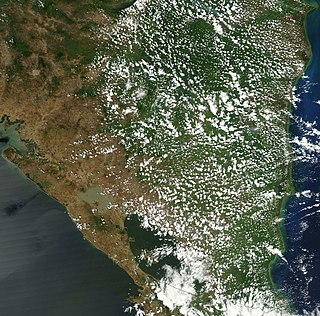
Nicaragua is a country in Central America, bordering both the Caribbean Sea and the North Pacific Ocean, between Costa Rica and Honduras. Nicaragua is the largest country in Central America in square kilometers.

Managua is the capital and largest city of Nicaragua, and one of the largest cities in Central America. Located on the shores of Lake Managua, the city had an estimated population of 1,055,247 as of 2020, and a population of 1,401,687 in its metropolitan area. The city also serves as the seat of Managua Department.

The Mosquito Coast is an area along the eastern coast of present-day Nicaragua and Honduras. It was named after the local Miskito Nation and was long dominated by British interests and known as the Mosquito Kingdom. From 1860 suzerainty of the area was transferred to Nicaragua with the name Mosquito Reserve, and in November 1894 the Mosquito Coast was militarily incorporated into Nicaragua. However, in 1960, the northern part was granted to Honduras by the International Court of Justice.
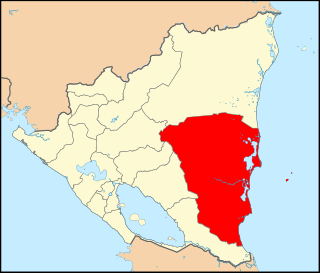
The South Caribbean Coast Autonomous Region is one of two autonomous regions in Nicaragua. It was created along with the North Caribbean Coast Autonomous Region by the Autonomy Statute of 7 September 1987 through a division of the former Zelaya Department. It covers an area of 27,260 km2 (10,530 sq mi) and has a population of 420,935. The capital is Bluefields. Bordering the Caribbean Sea, it contains part of the region known as Mosquitia.

Culture of Nicaragua is a fusion of Mesoamerican, Chibcha, and Spanish influence. The western part was colonized by the Spanish and its culture is similar to western El Salvador in that western Nicaragua was dominated by the Nahua people, specifically the Nicarao, a branch of the Pipil people. Nahua heritage can still be seen in Nicaraguan culture especially in its cuisines, the etymologies of many of its place names, and even DNA analysis. While western Nicaragua is mostly Indigenous of Nahua or Oto-manguean origin, eastern Nicaragua is mostly of Chibcha, Miskito, and African origin.

Nicaraguans are people inhabiting in, originating or having significant heritage from Nicaragua. Most Nicaraguans live in Nicaragua, although there is also a significant Nicaraguan diaspora, particularly in Costa Rica and the United States with smaller communities in other countries around the world. There are also people living in Nicaragua who are not Nicaraguans because they were not born or raised in Nicaragua nor have they gained citizenship.

Bluefields is the capital of the South Caribbean Autonomous Region in Nicaragua. It was also the capital of the former Kingdom of Mosquitia, and later the Zelaya Department, which was divided into North and South Caribbean Coast Autonomous Regions. It is located on Bluefields Bay at the mouth of the Bluefields River in the municipality of the same name.
Mískito Coast Creole or Nicaraguan Creole English is an English-based creole language spoken in coastal Nicaraguan region of Mosquito Coast on the Caribbean Sea; its approximately 40,000 speakers are spread over the RACCN and RACCS regions of Nicaragua. The region, known before 1986 as the Zelaya department, is today administratively separated into two autonomous regions: North Caribbean Coast (RACCN) and South Caribbean Coast (RACCS). Mosquito is the nickname that is given to the region and earlier residents by early Europeans who visited and settled in the area. The term "Miskito" is now more commonly used to refer to both the people and the language.
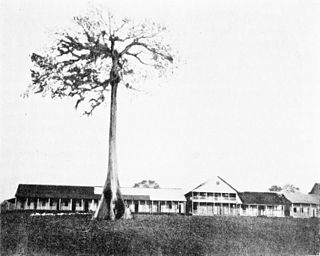
Rama is a municipality and a city in the South Caribbean Coast Autonomous Region of Nicaragua.
El Tortuguero is a municipality in the South Caribbean Coast Autonomous Region of Nicaragua. It is located at about 530 km from Managua and can only be reached by an hour-long truck ride from El Rama.
Kukra Hill(Loma de los Kukras) is a municipality in the South Caribbean Coast Autonomous Region in the Republic of Nicaragua. It was granted municipal status in 1989; before then, it was administratively part of the municipality of Bluefields, in the former department of Zelaya.

Pearl Lagoon is a municipality that is often time called just Lagoon and was historically known as English Bank. It is located in the South Caribbean Coast Autonomous Region of Nicaragua. It is the most important town of the largest coastal lagoon also by the name of Pearl Lagoon in the South Caribbean Coast Autonomous Region of Nicaragua and which the name of the town is derived from. As of 2022, Pearl Lagoon Municipality had a population of 21,360.

The Mayangna are a people who live on the eastern coasts of Nicaragua and Honduras, an area commonly known as the Mosquito Coast. Their preferred autonym is Mayangna, as the name "Sumo" is a derogatory name historically used by the Miskito people. Their culture is closer to that of the indigenous peoples of Costa Rica, Panama, and Colombia than to the Mesoamerican cultures to the north. The Mayangna inhabited much of the Mosquito Coast in the 16th century. Since then, they have become more marginalized following the emergence of the Miskito as a regional power.

The Indigenous peoples of Peru or Native Peruvians comprise a large number of ethnic groups who inhabit territory in present-day Peru. Indigenous cultures developed here for thousands of years before the arrival of the Spanish in 1532.
Chinese Nicaraguans are Nicaraguans of Chinese ancestry who immigrated to or born in Nicaragua. They are part of the Chinese diaspora.

The Central Institute of Higher Tibetan Studies, formerly called Central University for Tibetan Studies (CUTS), is a Deemed University founded in Sarnath, Varanasi, India, in 1967, as an autonomous organisation under Union Ministry of Culture. The CIHTS was founded by Pt. Jawahar Lal Nehru in consultation with Tenzin Gyatso, the 14th Dalai Lama, with the aim of educating Tibetan youths in exile and Himalayan border students as well as with the aim of retranslating lost Indo-Buddhist Sanskrit texts that now existed only in Tibetan, into Sanskrit, to Hindi, and other modern Indian languages.
The University of the Autonomous Regions of the Nicaraguan Caribbean Coast, is a university founded in 1994. It is described as an "intercultural university community for indigenous peoples and ethnic communities".
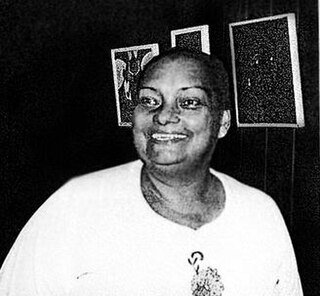
June Beer (1935–1986) was a Nicaraguan naïve artist, who gained national and international acclaim for her works depicting African and feminist themes. She was also the first woman poet of Nicaragua's Atlantic coast and produced works in Miskito Coast Creole, English and Spanish. The Nicaraguan government protected four of her paintings—Fruit Seller, In Memory of Efie Irene, They Dance and Woman Working—by declaring them as part of the national patrimony. Removing them from the country is illegal.
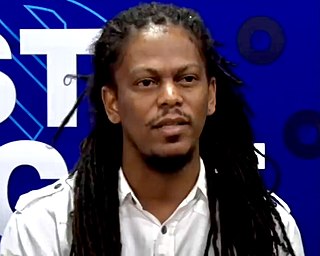
George Patrick Henriquez Cassayo is a Nicaraguan activist. Hailing from Nicaragua's Caribbean Coast, Henriquez is a former YATAMA party activist and served on its behalf as a member of the executive committee unified National Coalition opposition group in 2020. In 2021 he was a pre-candidate for president in the Nicaraguan general election with the Citizens for Liberty Alliance (ACxL).














